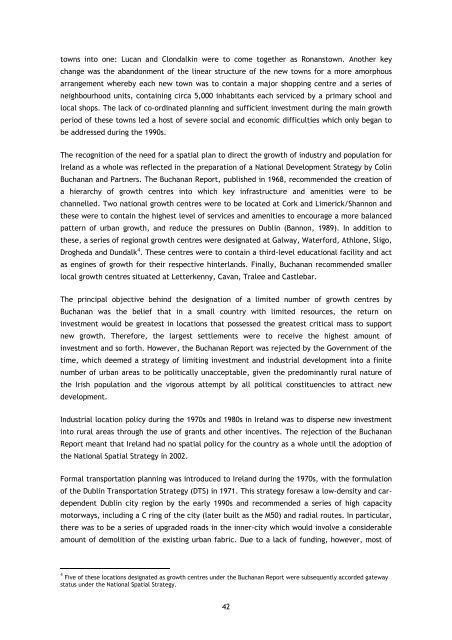TWICE THE SIZE - DIT Update - Dublin Institute of Technology
TWICE THE SIZE - DIT Update - Dublin Institute of Technology
TWICE THE SIZE - DIT Update - Dublin Institute of Technology
Create successful ePaper yourself
Turn your PDF publications into a flip-book with our unique Google optimized e-Paper software.
towns into one: Lucan and Clondalkin were to come together as Ronanstown. Another key<br />
change was the abandonment <strong>of</strong> the linear structure <strong>of</strong> the new towns for a more amorphous<br />
arrangement whereby each new town was to contain a major shopping centre and a series <strong>of</strong><br />
neighbourhood units, containing circa 5,000 inhabitants each serviced by a primary school and<br />
local shops. The lack <strong>of</strong> co-ordinated planning and sufficient investment during the main growth<br />
period <strong>of</strong> these towns led a host <strong>of</strong> severe social and economic difficulties which only began to<br />
be addressed during the 1990s.<br />
The recognition <strong>of</strong> the need for a spatial plan to direct the growth <strong>of</strong> industry and population for<br />
Ireland as a whole was reflected in the preparation <strong>of</strong> a National Development Strategy by Colin<br />
Buchanan and Partners. The Buchanan Report, published in 1968, recommended the creation <strong>of</strong><br />
a hierarchy <strong>of</strong> growth centres into which key infrastructure and amenities were to be<br />
channelled. Two national growth centres were to be located at Cork and Limerick/Shannon and<br />
these were to contain the highest level <strong>of</strong> services and amenities to encourage a more balanced<br />
pattern <strong>of</strong> urban growth, and reduce the pressures on <strong>Dublin</strong> (Bannon, 1989). In addition to<br />
these, a series <strong>of</strong> regional growth centres were designated at Galway, Waterford, Athlone, Sligo,<br />
Drogheda and Dundalk 4 . These centres were to contain a third-level educational facility and act<br />
as engines <strong>of</strong> growth for their respective hinterlands. Finally, Buchanan recommended smaller<br />
local growth centres situated at Letterkenny, Cavan, Tralee and Castlebar.<br />
The principal objective behind the designation <strong>of</strong> a limited number <strong>of</strong> growth centres by<br />
Buchanan was the belief that in a small country with limited resources, the return on<br />
investment would be greatest in locations that possessed the greatest critical mass to support<br />
new growth. Therefore, the largest settlements were to receive the highest amount <strong>of</strong><br />
investment and so forth. However, the Buchanan Report was rejected by the Government <strong>of</strong> the<br />
time, which deemed a strategy <strong>of</strong> limiting investment and industrial development into a finite<br />
number <strong>of</strong> urban areas to be politically unacceptable, given the predominantly rural nature <strong>of</strong><br />
the Irish population and the vigorous attempt by all political constituencies to attract new<br />
development.<br />
Industrial location policy during the 1970s and 1980s in Ireland was to disperse new investment<br />
into rural areas through the use <strong>of</strong> grants and other incentives. The rejection <strong>of</strong> the Buchanan<br />
Report meant that Ireland had no spatial policy for the country as a whole until the adoption <strong>of</strong><br />
the National Spatial Strategy in 2002.<br />
Formal transportation planning was introduced to Ireland during the 1970s, with the formulation<br />
<strong>of</strong> the <strong>Dublin</strong> Transportation Strategy (DTS) in 1971. This strategy foresaw a low-density and cardependent<br />
<strong>Dublin</strong> city region by the early 1990s and recommended a series <strong>of</strong> high capacity<br />
motorways, including a C ring <strong>of</strong> the city (later built as the M50) and radial routes. In particular,<br />
there was to be a series <strong>of</strong> upgraded roads in the inner-city which would involve a considerable<br />
amount <strong>of</strong> demolition <strong>of</strong> the existing urban fabric. Due to a lack <strong>of</strong> funding, however, most <strong>of</strong><br />
4<br />
Five <strong>of</strong> these locations designated as growth centres under the Buchanan Report were subsequently accorded gateway<br />
status under the National Spatial Strategy.<br />
42








